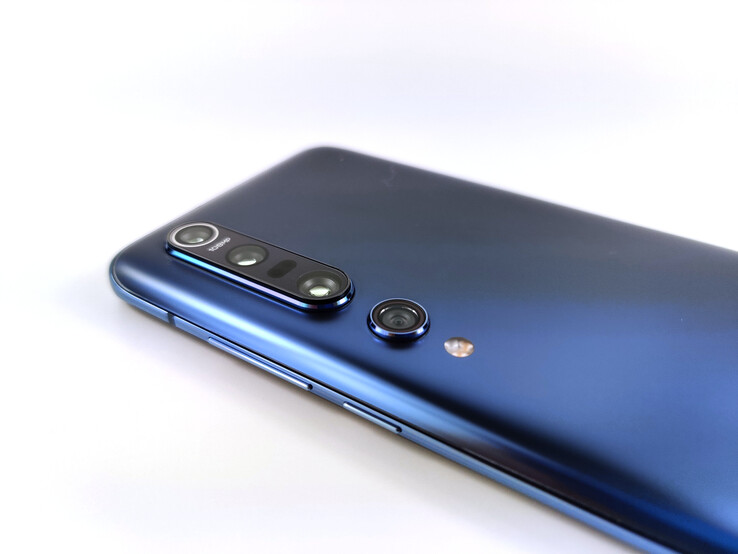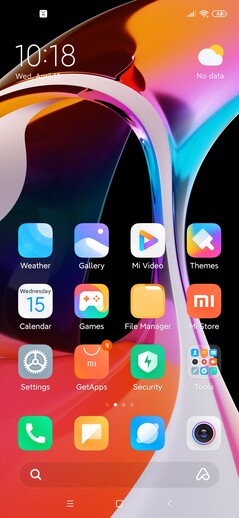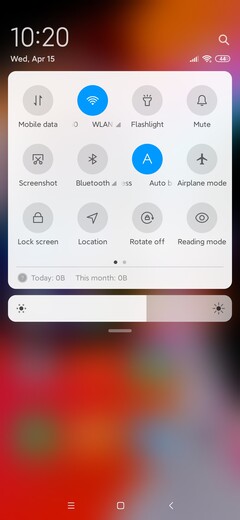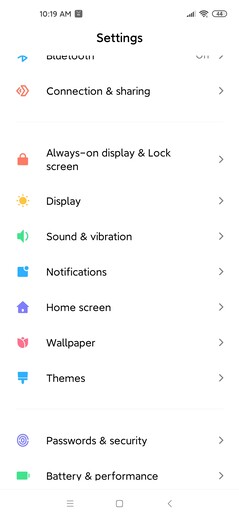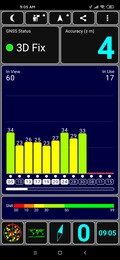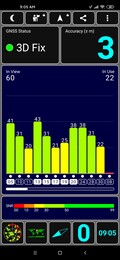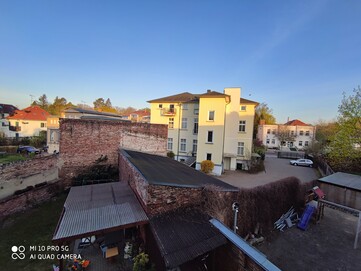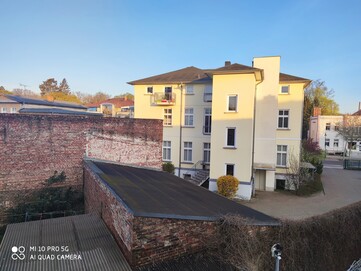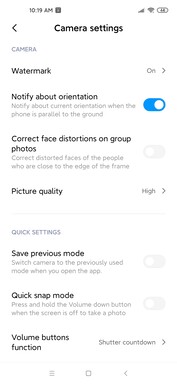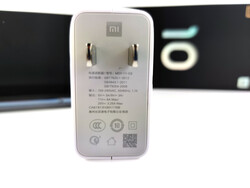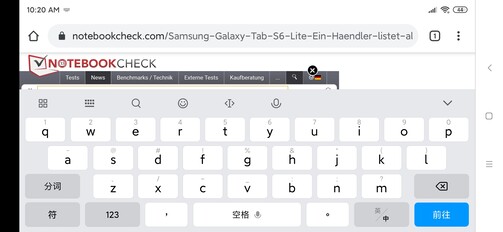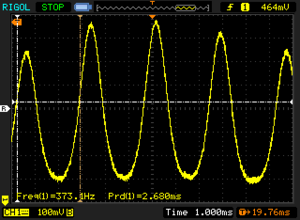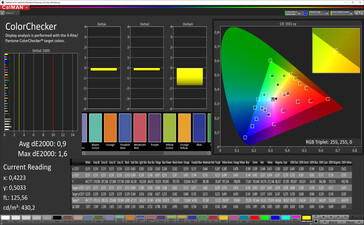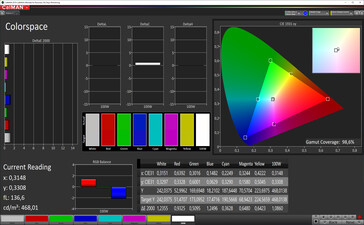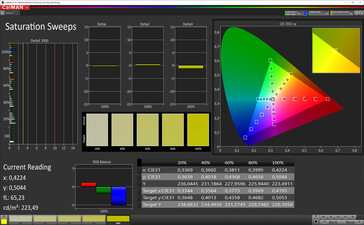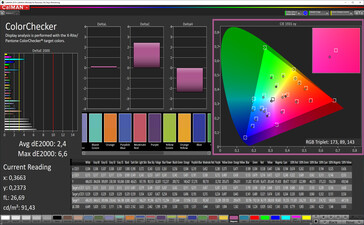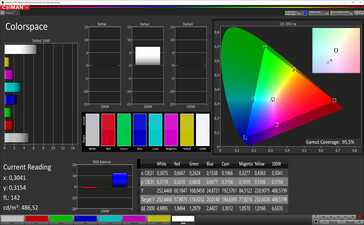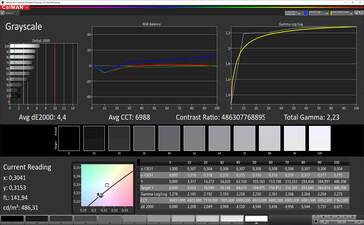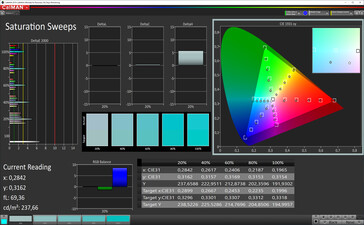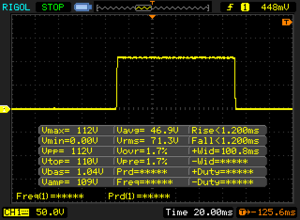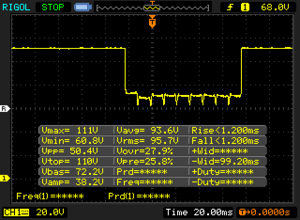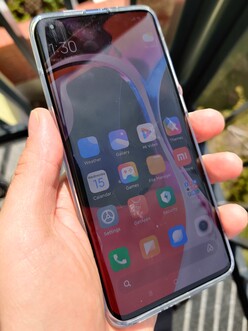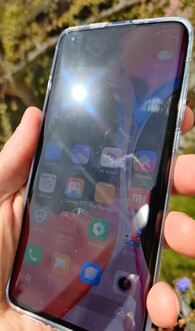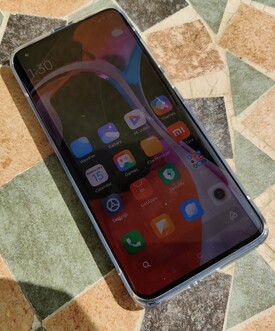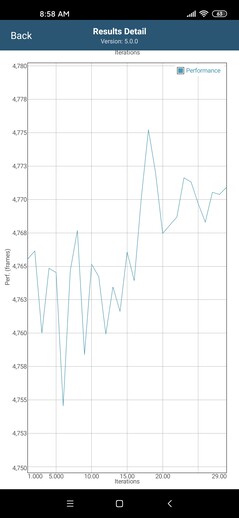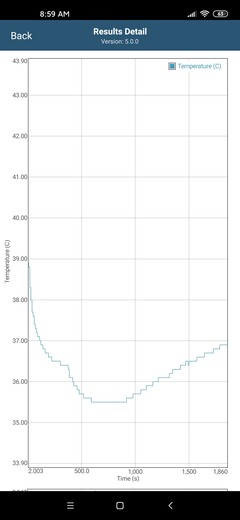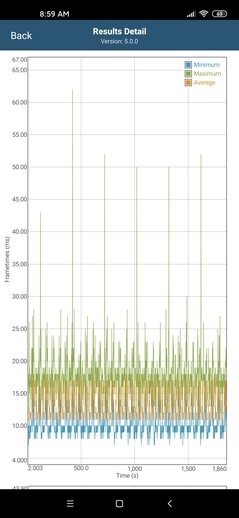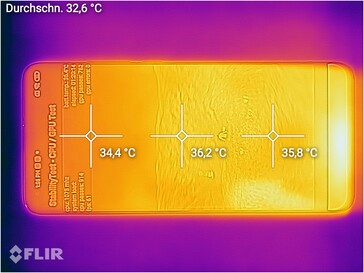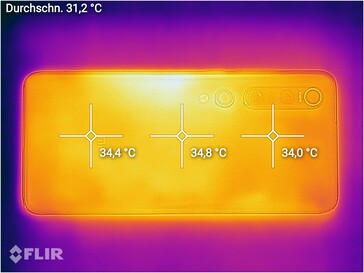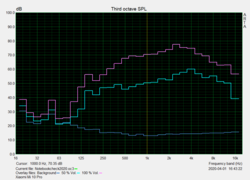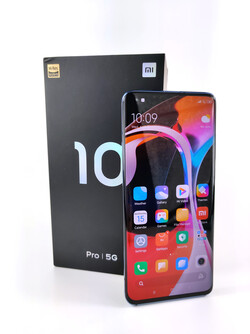Xiaomi Mi 10 Pro Smartphone Review: Xiaomi has joined the smartphone elite
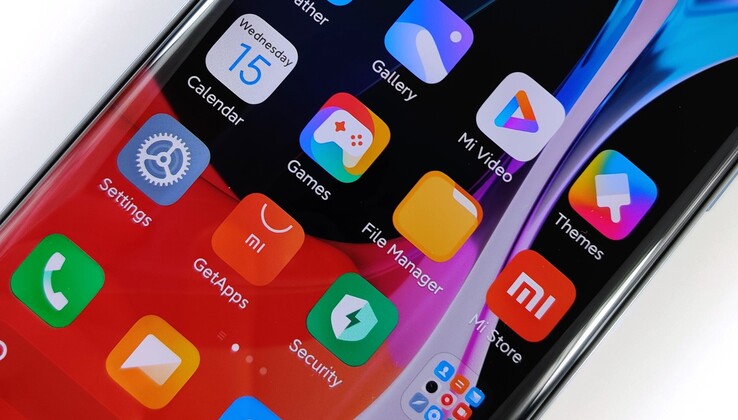
Similar to last year, Xiaomi is releasing two different models of the Mi 9 successor: The Mi 10 and the flagship model Mi 10 Pro - we have summarized the differences between the Mi 10 Pro and the "normal" variant here. The Pro version of the new Xiaomi flagship smartphone (8 GB RAM, 256 GB storage) can be purchased at an MSRP of 999 Euros (~$1,086). The Chinese version of the Xiaomi Mi 10 Pro has been available since February this year. Import retailers such as our lender TradingShenzhen currently demand about 730 Euros (~$794) for the device.
The Pro version of the current Mi generation features a quad camera setup with a 108-MP main camera supporting 8K video functionality and the Snapdragon 865. The high 90-Hz refresh rate of the Xiaomi phone's 6.67-inch edge-to-edge AMOLED display is almost a given in this price class.
Competing Devices
Rating | Date | Model | Weight | Drive | Size | Resolution | Price |
|---|---|---|---|---|---|---|---|
| 88.2 % v7 (old) | 04 / 2020 | Xiaomi Mi 10 Pro SD 865, Adreno 650 | 208 g | 256 GB UFS 3.0 Flash | 6.67" | 2340x1080 | |
| 88.9 % v7 (old) | 03 / 2020 | Samsung Galaxy S20 Ultra Exynos 990, Mali-G77 MP11 | 219 g | 128 GB UFS 3.0 Flash | 6.90" | 3200x1440 | |
| 89.4 % v7 (old) | 04 / 2020 | Huawei P40 Pro Kirin 990 5G, Mali-G76 MP16 | 209 g | 256 GB UFS 3.0 Flash | 6.58" | 2640x1200 | |
| 86.9 % v7 (old) | 11 / 2019 | OnePlus 7T Pro SD 855+, Adreno 640 | 206 g | 256 GB UFS 3.0 Flash | 6.67" | 3120x1440 | |
| 86.1 % v7 (old) | 03 / 2020 | Oppo Find X2 Pro SD 865, Adreno 650 | 202 g | 512 GB UFS 3.0 Flash | 6.70" | 3168x1440 | |
| 85.8 % v7 (old) | 04 / 2020 | Google Pixel 4 XL SD 855, Adreno 640 | 193 g | 64 GB UFS 2.1 Flash | 6.30" | 3040x1440 |
Case - Xiaomi Mi 10 Pro with a Waterfall Display
The waterfall display of the Mi 10 Pro curves into a metal frame. Even though with a 6.67-inch panel and a weight of 208 g (~7.34 oz) the Mi 10 Pro belongs to the phablet class, the high-end smartphone lies well in the hand. That being said, the transitions between the frame and the case are somewhat sharp. While the Mi 10 Pro does not have an IP certification, it comes with nano coating from P2i, which at least protects the Xiaomi phone against splash water.
The build quality and the actuation points of the physical buttons are excellent. The bezels around the display and the space taken up by the front camera punch hole are very small.
Features - Mi 10 Pro with UFS 3.0 Storage
The Xiaomi smartphone comes with Miracast, an IR blaster and USB OTG. Even the Chinese version of the Mi 10 Pro supports HD quality video-streaming via video-streaming services thanks to Widevine DRM level 1. Although the USB port has the Type-C form factor, it still only adheres to the USB 2.0 standard.
After the initial setup, 226 GB of 256 GB from the internal UFS 3.0 storage's total capacity is available to users. While the 512-GB version offers even more storage space, this configuration is currently only available for the Chinese version of the Mi 10 Pro. Furthermore, the Xiaomi phone is not compatible with SD card storage expansion.
Software - Xiaomi Smartphone with Android 10
The operating system of the Mi 10 Pro is based on Android 10 with security patches from March 2020. On top of the OS, the manufacturer has installed version 11 of its own MiUI. The MiUI is a heavily customized user interface that does not have much in common with stock Android anymore. In return, the system software not only offers visual tweaks but also numerous adjustments, while still being one of the fastest Android user interfaces.
The MiUI software of the Chinese version of the Mi 10 Pro does not support Google services such as the Play Store ex-factory. Instead, it relies on Chinese services and Xiaomi's own framework. Unlike Huawei's smartphones however, using Google services is still possible. Note: Since Google's frameworks have already been preinstalled on the Mi 10 Pro ex-factory, only the Play Store will have to be manually installed.
The international version of the Mi 10 Pro has access to the usual Google services and system localizations other than Chinese and English ex-factory.
Communication and GPS - Mi 10 Pro with Wi-Fi 6
In terms of the communications modules, Xiaomi uses the new 5G standard and Bluetooth version 5.1. For short-range networking, an NFC chip that supports Google Pay is also on board. The Mi 10 Pro supports a total of 14 LTE bands and covers almost all the relevant LTE frequencies for Europe - this includes LTE band 28, which will likely continue to become more relevant in the future. While the Chinese version lacks bands 20 and 28, the import model of the Xiaomi phone comes with a second nano-SIM slot. Furthermore, the European single-SIM version does not support eSIM.
Even when connected to a home Wi-Fi, the Mi 10 Pro does not disappoint. It supports the recent standard Wi-Fi 6 and 8x8 multi-user MIMO, which guarantees high and relatively consistent transfer speeds within home networks. In conjunction with our reference router Netgear Nighthawk AX12, the Xiaomi phone achieves transfer speeds of more than 800 Mb/s, which is excellent for a smartphone. Only the Huawei P40 Pro is equipped with an even faster Wi-Fi modem.
| Networking | |
| iperf3 transmit AX12 | |
| Huawei P40 Pro | |
| Samsung Galaxy S20 Ultra | |
| Xiaomi Mi 10 Pro | |
| Oppo Find X2 Pro | |
| OnePlus 7T Pro | |
| Google Pixel 4 XL | |
| iperf3 receive AX12 | |
| Xiaomi Mi 10 Pro | |
| Samsung Galaxy S20 Ultra | |
| Huawei P40 Pro | |
| Oppo Find X2 Pro | |
| Google Pixel 4 XL | |
| OnePlus 7T Pro | |
Like with its predecessor, the Mi 10 Pro also supports the dual-GPS feature, which combines bands L1 and L5, the latter of which is primarily used in the professional sector, to give more accurate locating capabilities. With GPS, GLONASS, Galileo, BeiDou, QZSS and the satellite support system SBAS, it uses the full range of satellite networks for geolocation.
In order to evaluate the accuracy of our test device in practice, we simultaneously recorded our route with the Garmin Edge 500 and the high-end smartphone for comparison. At the end of our test track with a total length of 12.5 kilometers (~7.67 miles), around 170 meters (~558 feet) separates the smartphone GPS module and the dedicated navigation device. Since the detailed view of the GPS only shows minor deviations from the route, there is no reason not to use the Mi 10 Pro for navigation purposes.
Telephony and Call Quality - Xiaomi Phone with VoLTE
The call quality within the German Vodafone network is nothing out of the ordinary. Voices can be clearly understood and our conversational partner also characterizes us as clearly audible. Furthermore, VoLTE and Wi-Fi calling are supported.
Video calls via Skype with the integrated front camera worked without any issues in our test. The call quality of the integrated speaker is good and voices captured by the integrated microphone offer a good level of volume and clarity.
Cameras - Mi 10 Pro with a 108-MP Camera
The punch hole on the front houses a 20-MP camera with a fixed-focus lens and HDR support. While the quality of the pictures is good, videos cannot be recorded at 4K resolution.
The 108-MP sensor ISOCELL Bright HMX serves as the main camera of the Mi 10 Pro and is able to capture videos at up to 8K and 30 frames per second, while up to 60 FPS is supported in UHD quality and a staggering 960 FPS at 1080p. Since unlike the Samsung Galaxy S20 Ultra the Xiaomi flagship only combines four pixels into one super pixel instead of nine, pictures taken with the Mi 10 Pro have a higher resolution (27 MP) - even when using pixel-binning. In well-lit scenes, the 1/1.33-inch sensor offers good sharpness, color accuracy and a wide dynamic range. However, compared to the Galaxy S20 Ultra, a few details get lost and the borders of objects appear somewhat soft-focused. Similarly, the sharpness at the edges of pictures is not within the optimal range.
Unlike previous Mi smartphones, the Mi 10 Pro's camera performance in low-light situations is now competitive. The sensor is able to catch a lot of light from the environment and the autofocus works well in the dark.
The main camera is accompanied by a telephoto optics with 12 MP (1/2.6-inch sensor or 50 mm) and a secondary telephoto lens with 8 MP (1/4.4-inch sensor or 94 mm, OIS) for pictures at higher zoom levels. Their quality is very high. The Xiaomi cameras are able to capture an incredible amount of detail both at 5x and 10x zoom. Similarly, the dynamic range and sharpness of the photos are impressive. While low-light situations introduce image noise and reduce the sharpness, the Mi 10 Pro is still one of the best zoom smartphones in this discipline.
The ultra-wide-angle cam with a resolution of 20 MP (1/2.8-inch sensor with 16-mm optics) is the weakest part of the camera setup. The Mi 10 Pro's wide-angle shots lack sharpness and details compared to other flagships and particularly the P40 Pro has an advantage due to its RYYB sensor. The position of the sensor is impractical as well, since it is located below the other cameras, which can often cause it to be accidentally blocked with a finger.
Under controlled lightning conditions, the Mi 10 Pro shows a natural color reproduction with only slightly overbrightened colors. Our test charts illustrate the camera's issues when trying to focus the 108-MP camera under synthetic lighting, although this will be less of an issue during day-to-day use - unlike the behavior we observed from the Samsung Galaxy S20 Ultra.
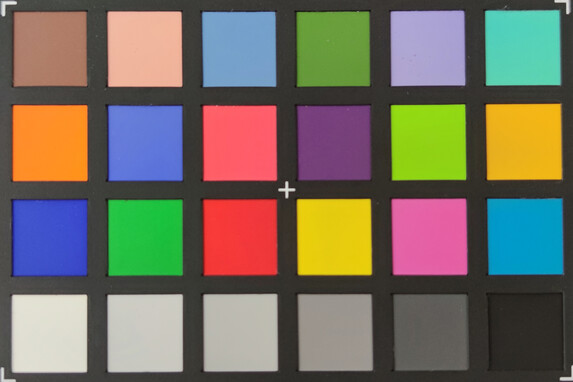

Accessories and Warranty - 65-W Charger Included with the Mi 10 Pro
The Mi 10 Pro's scope of delivery includes a modular 65-watt charger, a USB cable and a protective case. Additionally, our lender TradingShenzhen has extended the package contents of our Chinese version with an EU adapter and a USB OTG adapter.
The warranty period of the Xiaomi smartphone is 12 months. In the case of our import device from TradingShenzhen, EU buyers have the option to send the smartphone to a German address in a warranty case.
Input Devices & Handling - Xiaomi Phone Supports a 180-Hz Sampling Rate
The refresh rate of the display (90 Hz) is not the only frequency to exceed the 60-Hz mark: Thanks to the touchscreen's sampling rate of 180 Hz, the 6.67-inch OLED panel is particularly responsive all the way into the edges.
Below the Mi 10 Pro's display, there is an optical fingerprint sensor that responds very quickly as well. Similarly, the Xiaomi phone can be quickly and reliably unlocked via biometric authentication with the front camera's facial recognition, although this method is not particularly secure (2D).
The vibration system is an often overlooked but fairly noticeable feature during daily use. The vibration motor of the Mi 10 Pro produces a crisp haptic feedback and appears to be of a high quality, which results in a very comfortable typing experience on the Xiaomi phone.
Display - Mi 10 Pro with HDR10+ and 90 Hz
In our test, we measured a very high luminance of 762 cd/m² from the 6.67-inch Super AMOLED display with an even illumination. Furthermore, we measured the brightness level of an evenly distributed portion of black and white areas (APL50). At 948 cd/m², the brightness was very high in this test as well. Meanwhile, the OLED panel only achieves a maximum brightness of 490 cd/m² with the ambient light sensor disabled.
While digital content appears sharp on the display thanks to its resolution of 2340x1080 pixels, direct competitors are able to offer resolutions of up to 1440p and the refresh rate of the Mi 10 Pro is also exceeded by a few flagship smartphones such as the Oppo Find X2 Pro or OnePlus 8 Pro, both of which support 120 Hz.
The Xiaomi smartphone uses pulse-width modulation (PWM) at a relatively high frequency of 347.2-373.1 Hz to control the screen's brightness even at the maximum brightness setting. Additionally, there is a DC dimming mode.
| |||||||||||||||||||||||||
Brightness Distribution: 96 %
Center on Battery: 753 cd/m²
Contrast: ∞:1 (Black: 0 cd/m²)
ΔE ColorChecker Calman: 0.9 | ∀{0.5-29.43 Ø4.77}
ΔE Greyscale Calman: 1.5 | ∀{0.09-98 Ø5}
98.6% sRGB (Calman 2D)
Gamma: 2.24
CCT: 6415 K
| Xiaomi Mi 10 Pro Super AMOLED, 2340x1080, 6.7" | Samsung Galaxy S20 Ultra Dynamic AMOLED 2X, 3200x1440, 6.9" | Huawei P40 Pro OLED, 2640x1200, 6.6" | OnePlus 7T Pro AMOLED, 3120x1440, 6.7" | Oppo Find X2 Pro AMOLED, 3168x1440, 6.7" | Google Pixel 4 XL P-OLED, 3040x1440, 6.3" | OnePlus 8 Pro AMOLED, 3168x1440, 6.8" | |
|---|---|---|---|---|---|---|---|
| Screen | -111% | -22% | -102% | -183% | -134% | 10% | |
| Brightness middle (cd/m²) | 753 | 734 -3% | 584 -22% | 606 -20% | 778 3% | 557 -26% | 796 6% |
| Brightness (cd/m²) | 762 | 748 -2% | 576 -24% | 611 -20% | 775 2% | 555 -27% | 779 2% |
| Brightness Distribution (%) | 96 | 95 -1% | 95 -1% | 95 -1% | 99 3% | 95 -1% | 94 -2% |
| Black Level * (cd/m²) | |||||||
| Colorchecker dE 2000 * | 0.9 | 3.2 -256% | 1.1 -22% | 3.46 -284% | 4.4 -389% | 3.9 -333% | 0.68 24% |
| Colorchecker dE 2000 max. * | 1.6 | 6.8 -325% | 2.3 -44% | 5.64 -253% | 8.7 -444% | 6.1 -281% | 1.55 3% |
| Greyscale dE 2000 * | 1.5 | 2.7 -80% | 1.8 -20% | 2 -33% | 5.6 -273% | 3.5 -133% | 1.1 27% |
| Gamma | 2.24 98% | 2.11 104% | 2.16 102% | 2.258 97% | 2.26 97% | 2.18 101% | 2.237 98% |
| CCT | 6415 101% | 6299 103% | 6355 102% | 6779 96% | 7250 90% | 6127 106% | 6310 103% |
* ... smaller is better
Screen Flickering / PWM (Pulse-Width Modulation)
| Screen flickering / PWM detected | 373.1 Hz | ≤ 99 % brightness setting | |
The display backlight flickers at 373.1 Hz (worst case, e.g., utilizing PWM) Flickering detected at a brightness setting of 99 % and below. There should be no flickering or PWM above this brightness setting. The frequency of 373.1 Hz is relatively high, so most users sensitive to PWM should not notice any flickering. However, there are reports that some users are still sensitive to PWM at 500 Hz and above, so be aware. In comparison: 53 % of all tested devices do not use PWM to dim the display. If PWM was detected, an average of 8084 (minimum: 5 - maximum: 343500) Hz was measured. | |||
The great contrast ratio aside, the Mi 10 Pro also supports HDR10+ and it offers a large color-space coverage. The panel is already calibrated very well ex-factory and is the reference for smartphones together with the OnePlus 8 Pro. The analysis from our spectrophotometer and the CalMAN software outputs very low DeltaE deviations of just 0.9 (colors) and 1.5 (grayscale) from the sRGB color space (profile: standard). That being said, the smaller color space will have to be used in order to achieve this level of precision.
Display Response Times
| ↔ Response Time Black to White | ||
|---|---|---|
| 2.4 ms ... rise ↗ and fall ↘ combined | ↗ 1.2 ms rise | |
| ↘ 1.2 ms fall | ||
| The screen shows very fast response rates in our tests and should be very well suited for fast-paced gaming. In comparison, all tested devices range from 0.1 (minimum) to 240 (maximum) ms. » 11 % of all devices are better. This means that the measured response time is better than the average of all tested devices (20.2 ms). | ||
| ↔ Response Time 50% Grey to 80% Grey | ||
| 2.4 ms ... rise ↗ and fall ↘ combined | ↗ 1.2 ms rise | |
| ↘ 1.2 ms fall | ||
| The screen shows very fast response rates in our tests and should be very well suited for fast-paced gaming. In comparison, all tested devices range from 0.165 (minimum) to 636 (maximum) ms. » 10 % of all devices are better. This means that the measured response time is better than the average of all tested devices (31.6 ms). | ||
Performance - Powerful Snapdragon 865 Inside the Mi 10 Pro
The Qualcomm Snapdragon 865 inside the Mi 10 Pro houses one fast "prime core" with a clock speed of up to 2.84 GHz and three additional performance cores based on the Cortex A77 microarchitecture with a clock rate of up to 2.42 GHz. Furthermore, there are four ARM Cortex A55 cores (1.8 GHz). Meanwhile, graphics calculations are handled by the Qualcomm SoC's potent Adreno 650 graphics unit.
The system performance of the Mi 10 Pro is superb. Navigating the OS is smooth and there are barely any stutters. Thanks to fast UFS storage and a responsive panel, applications start nearly without any delay.
Combined with 8 GB of LPDDR5 memory, the Snapdragon 865 in our test device achieves a high level of performance. The results from our CPU benchmark measurements for the most part match those of the Oppo Find X2 Pro. When it comes to pure graphics workloads, the Mi 10 Pro tends to score much higher than the Oppo phone and while it achieves similar results as the Samsung Galaxy S20 Ultra with the Mali-G77 MP11, the lower resolution is of course a factor.
| AnTuTu v8 - Total Score (sort by value) | |
| Xiaomi Mi 10 Pro | |
| Samsung Galaxy S20 Ultra | |
| Huawei P40 Pro | |
| OnePlus 7T Pro | |
| Oppo Find X2 Pro | |
| Google Pixel 4 XL | |
| Average Qualcomm Snapdragon 865 (527301 - 631025, n=24) | |
| VRMark - Amber Room (sort by value) | |
| Xiaomi Mi 10 Pro | |
| Samsung Galaxy S20 Ultra | |
| Huawei P40 Pro | |
| OnePlus 7T Pro | |
| Oppo Find X2 Pro | |
| Average Qualcomm Snapdragon 865 (4988 - 7649, n=4) | |
Compared to its competitors, the Xiaomi smartphone also places high in the web-based benchmarks. Subjectively, the Chrome browser feels very responsive and the loading times are short, even with complex page content.
| Jetstream 2 - 2.0 Total Score | |
| Average of class Smartphone (23.8 - 387, n=148, last 2 years) | |
| Huawei P40 Pro (Huawei Browser 10.1) | |
| Xiaomi Mi 10 Pro (Chrome 81) | |
| Oppo Find X2 Pro (Chrome 80) | |
| Average Qualcomm Snapdragon 865 (45.2 - 77, n=20) | |
| OnePlus 7T Pro (Chrome 78) | |
| Samsung Galaxy S20 Ultra (Chrome 80) | |
| JetStream 1.1 - Total Score | |
| Huawei P40 Pro (Huawei Browser 10.1) | |
| OnePlus 7T Pro (Chrome 78) | |
| Xiaomi Mi 10 Pro (Chrome 81) | |
| Oppo Find X2 Pro (Chrome 80) | |
| Average Qualcomm Snapdragon 865 (74.2 - 145.1, n=21) | |
| Samsung Galaxy S20 Ultra (Chrome 80) | |
| Google Pixel 4 XL (Chrome 80) | |
| Speedometer 2.0 - Result 2.0 | |
| Average of class Smartphone (15.2 - 643, n=121, last 2 years) | |
| Huawei P40 Pro (Huawei Browser 10.1) | |
| Oppo Find X2 Pro (Chrome 80) | |
| Xiaomi Mi 10 Pro (Chrome 81) | |
| OnePlus 7T Pro (Chome 78) | |
| Average Qualcomm Snapdragon 865 (30.6 - 74.5, n=19) | |
| Samsung Galaxy S20 Ultra (Chrome 80) | |
| WebXPRT 3 - Overall | |
| Average of class Smartphone (38 - 380, n=31, last 2 years) | |
| Average Qualcomm Snapdragon 865 (97 - 127, n=23) | |
| Xiaomi Mi 10 Pro (Chrome 81) | |
| Google Pixel 4 XL (Chrome 80) | |
| Oppo Find X2 Pro (Chrome 80) | |
| OnePlus 7T Pro (Chrome 78) | |
| Samsung Galaxy S20 Ultra (Chrome 80) | |
| Huawei P40 Pro | |
| Octane V2 - Total Score | |
| Average of class Smartphone (2228 - 126661, n=196, last 2 years) | |
| Google Pixel 4 XL (Chrome 80) | |
| OnePlus 7T Pro (Chrome 78) | |
| Huawei P40 Pro (Huawei Browser 10.1) | |
| Oppo Find X2 Pro (Chrome 80) | |
| Xiaomi Mi 10 Pro (Chrome 81) | |
| Average Qualcomm Snapdragon 865 (14606 - 31224, n=23) | |
| Samsung Galaxy S20 Ultra (Chrome 80) | |
| Mozilla Kraken 1.1 - Total | |
| Google Pixel 4 XL (Chrome 80) | |
| Samsung Galaxy S20 Ultra (Chrome 80) | |
| OnePlus 7T Pro (Chrome 78) | |
| Oppo Find X2 Pro (Chrome 80) | |
| Average Qualcomm Snapdragon 865 (1623 - 2911, n=24) | |
| Xiaomi Mi 10 Pro (Chrome 81) | |
| Huawei P40 Pro (Huawei Browser 10.1) | |
| Average of class Smartphone (257 - 28190, n=156, last 2 years) | |
* ... smaller is better
| Xiaomi Mi 10 Pro | Samsung Galaxy S20 Ultra | Huawei P40 Pro | OnePlus 7T Pro | Oppo Find X2 Pro | Google Pixel 4 XL | Average 256 GB UFS 3.0 Flash | Average of class Smartphone | |
|---|---|---|---|---|---|---|---|---|
| AndroBench 3-5 | -13% | -14% | -47% | -14% | -52% | -21% | 56% | |
| Sequential Read 256KB (MB/s) | 1739 | 1632 -6% | 1775 2% | 1489 -14% | 1606 -8% | 871 -50% | 1547 ? -11% | 2253 ? 30% |
| Sequential Write 256KB (MB/s) | 750 | 697 -7% | 395.7 -47% | 405 -46% | 729 -3% | 197.4 -74% | 575 ? -23% | 1878 ? 150% |
| Random Read 4KB (MB/s) | 264.9 | 202.4 -24% | 228.1 -14% | 169 -36% | 202.6 -24% | 142.2 -46% | 210 ? -21% | 298 ? 12% |
| Random Write 4KB (MB/s) | 258.5 | 221.4 -14% | 271.8 5% | 26 -90% | 205 -21% | 164.2 -36% | 188.5 ? -27% | 342 ? 32% |
Gaming - Mi 10 Pro Is a 90-Hz Gaming Machine
As expected, we encountered no issues with the integrated gyroscope or the touchscreen of the Mi 10 Pro while gaming. The strong graphics unit Adreno 650 offers enough performance to display even demanding games from the Play Store smoothly - Asphalt 9 scratches the 30-FPS mark at high quality settings, while PUBG mobile runs at a frame rate of 40 FPS. Older games such as Dead Trigger 2 are playable at a fairly consistent frame rate of 90 FPS, which means they can take full advantage of the screen's high refresh rate. We used the app GameBench to measure the frame rates.
PUBG Mobile
Asphalt 9 Legends
Dead Trigger 2
Emissions - Xiaomi Phone with Excellent Audio
Temperature
Even under continuous load, the case temperature of the high-end smartphone barely increases. Inside the Mi 10 Pro, the VC liquid cooling solution is supposed to keep temperatures at an acceptable level.
Apart from the vapor chamber (VC) cooling solution, which has a relatively large footprint for a smartphone solution at 30 cm², Xiaomi uses six layers of graphite, copper foil, and thermal conductive gel. In order to test the cooling solution of the Mi 10 Pro, we used GFXBench's battery test to analyze the heat development of the Qualcomm SoC under continuous stress. In the demanding Manhattan test (OpenGL ES 3.1), the Mi 10 Pro barely showed any throttling behavior. Thus, performance drops during daily use, for example while gaming, are very unlikely.
(+) The maximum temperature on the upper side is 33.1 °C / 92 F, compared to the average of 35.2 °C / 95 F, ranging from 21.9 to 247 °C for the class Smartphone.
(+) The bottom heats up to a maximum of 30.7 °C / 87 F, compared to the average of 34 °C / 93 F
(+) In idle usage, the average temperature for the upper side is 29.1 °C / 84 F, compared to the device average of 32.9 °C / 91 F.
Speakers
The Mi 10 Pro has an integrated, symmetrically positioned dual-speaker system on the top and bottom edge of the case. The symmetrical arrangement of the speakers allows the Mi 10 Pro to produce true stereo sound. The setup consists of two 1216 super-linear speakers with seven magnetic units each and a 1.2 cc-equivalent speaker chamber that amplify the sound.
All in all, the Mi 10 Pro produces an impressive sound for a smartphone. While it comes as no surprise that the sound lacks bass, the audio experience is very linear overall. As our pink noise graph shows, the falloff at extremely high frequencies is also very minor.
Although Xiaomi has omitted the headphone jack on its Mi 10 Pro, music playback via the USB port has a good level of volume and clarity. Users who wish to use wireless headphones or Bluetooth speakers benefit from aptX HD and AAC as well as LDAC support.
Xiaomi Mi 10 Pro audio analysis
(+) | speakers can play relatively loud (84.5 dB)
Bass 100 - 315 Hz
(-) | nearly no bass - on average 16.1% lower than median
(±) | linearity of bass is average (13.6% delta to prev. frequency)
Mids 400 - 2000 Hz
(+) | balanced mids - only 3% away from median
(+) | mids are linear (3.3% delta to prev. frequency)
Highs 2 - 16 kHz
(±) | higher highs - on average 5.3% higher than median
(+) | highs are linear (4.9% delta to prev. frequency)
Overall 100 - 16.000 Hz
(±) | linearity of overall sound is average (15% difference to median)
Compared to same class
» 2% of all tested devices in this class were better, 2% similar, 96% worse
» The best had a delta of 11%, average was 35%, worst was 134%
Compared to all devices tested
» 20% of all tested devices were better, 4% similar, 76% worse
» The best had a delta of 4%, average was 24%, worst was 134%
Samsung Galaxy S20 Ultra audio analysis
(+) | speakers can play relatively loud (84.4 dB)
Bass 100 - 315 Hz
(-) | nearly no bass - on average 20.5% lower than median
(±) | linearity of bass is average (12.8% delta to prev. frequency)
Mids 400 - 2000 Hz
(+) | balanced mids - only 4.5% away from median
(+) | mids are linear (4.5% delta to prev. frequency)
Highs 2 - 16 kHz
(±) | higher highs - on average 6.3% higher than median
(+) | highs are linear (3% delta to prev. frequency)
Overall 100 - 16.000 Hz
(±) | linearity of overall sound is average (19% difference to median)
Compared to same class
» 24% of all tested devices in this class were better, 9% similar, 67% worse
» The best had a delta of 11%, average was 35%, worst was 134%
Compared to all devices tested
» 44% of all tested devices were better, 8% similar, 48% worse
» The best had a delta of 4%, average was 24%, worst was 134%
Energy Management - Mi 10 Pro with 30-W Wireless Charging
Energy Consumption
Xiaomi has equipped its flagship smartphone with a 4,500 mAh battery that supports wired (50 W) and wireless (30 W) quick charging. Reverse wireless charging with up to 10 watts is possible as well. While a charging time of 50 minutes means that the Mi 10 Pro does not charge quite as quickly as the Oppo Find X2 Pro, the charging times of the Xiaomi phone relative to its high battery capacity are very short. The energy consumption is very low, particularly while idling.
| Off / Standby | |
| Idle | |
| Load |
|
Key:
min: | |
| Xiaomi Mi 10 Pro 4500 mAh | Samsung Galaxy S20 Ultra 5000 mAh | Huawei P40 Pro 4200 mAh | OnePlus 7T Pro 4085 mAh | Oppo Find X2 Pro 4260 mAh | Google Pixel 4 XL 3700 mAh | Average Qualcomm Snapdragon 865 | Average of class Smartphone | |
|---|---|---|---|---|---|---|---|---|
| Power Consumption | -35% | -9% | -121% | -118% | -14% | -62% | -38% | |
| Idle Minimum * (Watt) | 0.61 | 0.76 -25% | 0.92 -51% | 2.1 -244% | 1.47 -141% | 0.83 -36% | 1.133 ? -86% | 0.846 ? -39% |
| Idle Average * (Watt) | 1.19 | 1.91 -61% | 1.41 -18% | 3 -152% | 3.43 -188% | 1.24 -4% | 2.23 ? -87% | 1.444 ? -21% |
| Idle Maximum * (Watt) | 1.23 | 1.96 -59% | 1.47 -20% | 3.5 -185% | 3.52 -186% | 1.25 -2% | 2.45 ? -99% | 1.627 ? -32% |
| Load Average * (Watt) | 4.18 | 4.72 -13% | 3.35 20% | 5.3 -27% | 6.2 -48% | 4.98 -19% | 5.26 ? -26% | 7.04 ? -68% |
| Load Maximum * (Watt) | 8.53 | 10.15 -19% | 6.37 25% | 8.3 3% | 10.63 -25% | 9.09 -7% | 9.68 ? -13% | 11.3 ? -32% |
* ... smaller is better
Battery Life
The results of our Wi-Fi test suggest excellent web-browsing runtimes for the Mi 10 Pro despite its 90-Hz screen, and even with intensive use, hardcore users should be able to easily make it through a day on one battery charge.
| Xiaomi Mi 10 Pro 4500 mAh | Samsung Galaxy S20 Ultra 5000 mAh | Huawei P40 Pro 4200 mAh | OnePlus 7T Pro 4085 mAh | Oppo Find X2 Pro 4260 mAh | Google Pixel 4 XL 3700 mAh | |
|---|---|---|---|---|---|---|
| Battery runtime | -0% | -7% | 10% | -24% | -28% | |
| Reader / Idle (h) | 35.6 | 31 -13% | 24.6 -31% | 33.6 -6% | ||
| H.264 (h) | 16.2 | 18.9 17% | 19 17% | 16 -1% | ||
| WiFi v1.3 (h) | 14.4 | 12 -17% | 12.4 -14% | 15.2 6% | 10.9 -24% | 10.4 -28% |
| Load (h) | 3.3 | 3.7 12% | 3.3 0% | 4.7 42% |
Pros
Cons
Verdict - Competitive Bundle with Gaps on the Datasheet
For the first time, a Xiaomi phone not only comes close to elite smartphones but also finds itself among them - this is also reflected by the price. While at almost 1,000 Euros (~$1,086), the Mi series of the Chinese manufacturer is no longer the value proposition that it has been for years, buyers now receive a premium smartphone experience that competes with those of flagship smartphones from other manufacturers. The stand-out features include the high quality of the installed vibration unit, quite possibly the best stereo speakers you can find on a smartphone, an excellent build quality and great cameras, although the quality of the wide-angle-lens still falls short of the ones on the Samsung Galaxy S20 Ultra and the Huawei P40 Pro in particular. However, this is compensated for by the zoom features of the Mi 10 Pro (up to 10x zoom), which are superior compared to the periscope cameras of the competition.
Similarly, the display is worthy of a 2020 flagship smartphone. The panel of the Mi 10 Pro features a high refresh rate, good color accuracy and a high luminosity. Meanwhile, the criticisms asking why the Chinese manufacturer has not gone all out (120 Hz, 1440p) are valid, even though most people's day-to-day use is unlikely to be adversely affected in any meaningful way, particularly in a direct comparison with the experience of the OnePlus 8 Pro. Other sore spots are the lack of an IP certification and the USB port being limited to 2.0 speeds.
Yes, the Mi series is no longer cheap. However, the very high MSRP of the Xiaomi flagship is justified - at least relative to other smartphones within the high-end segment.
Xiaomi Mi 10 Pro
- 09/03/2022 v7 (old)
Marcus Herbrich





